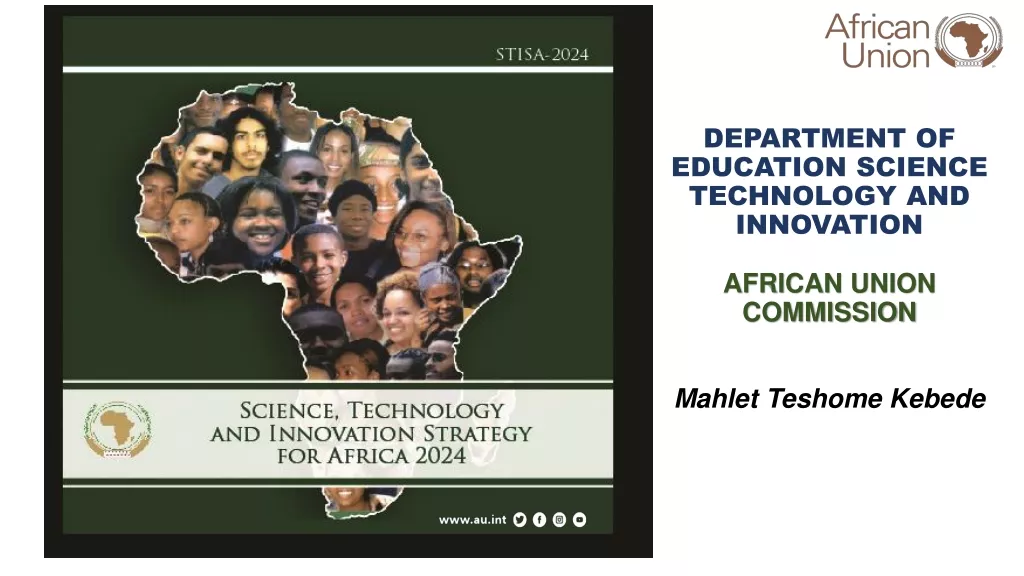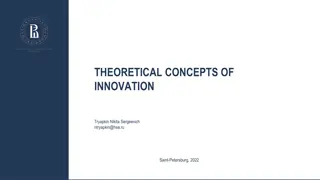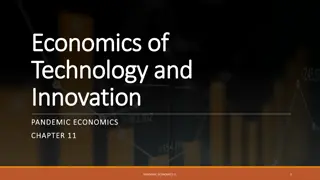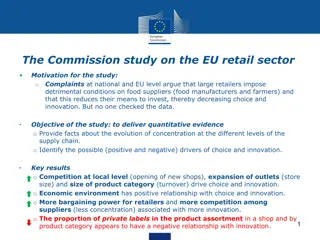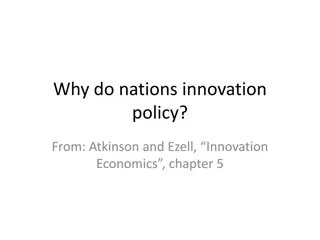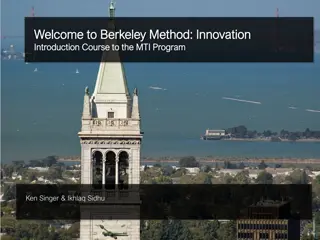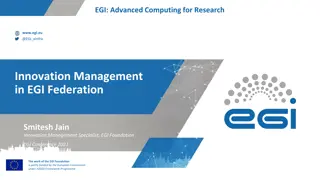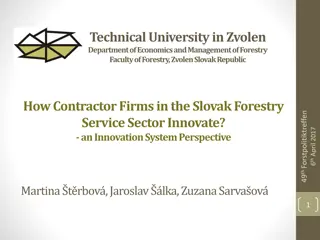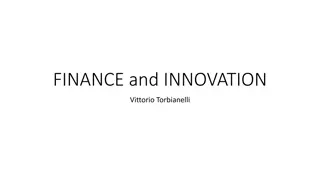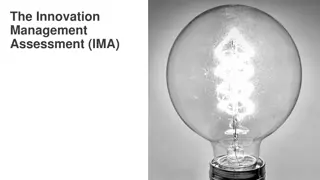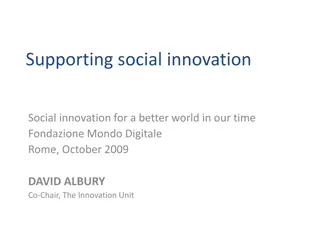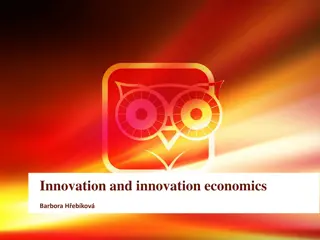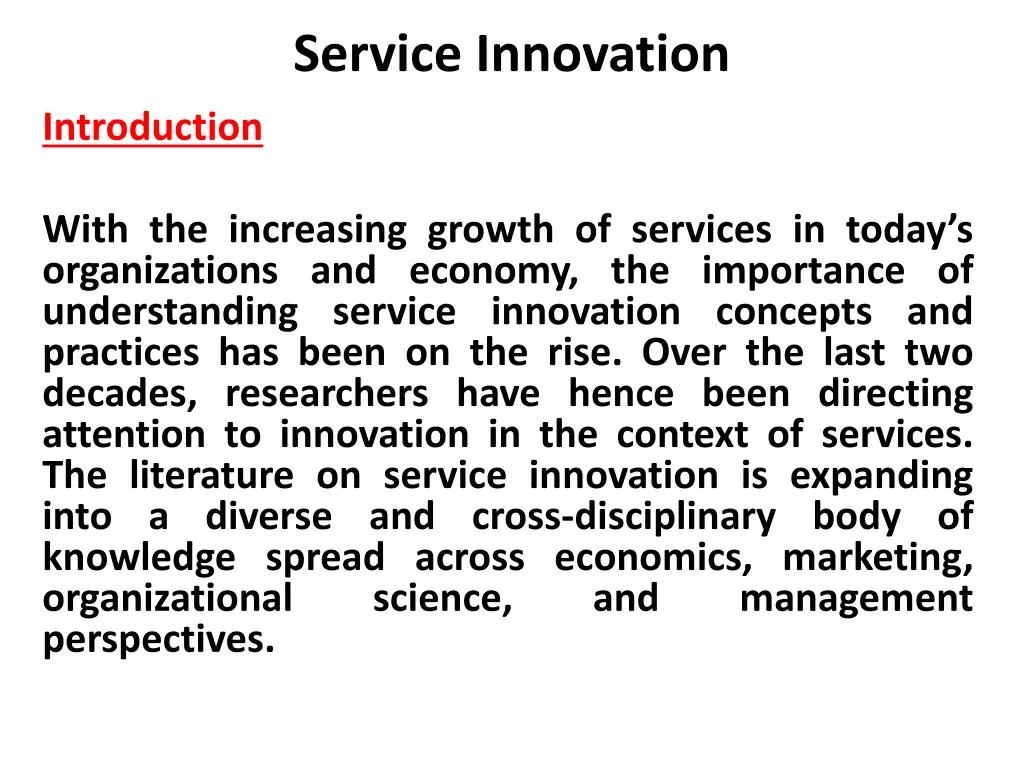
Understanding the Significance of Service Innovation in Today's Economy
Explore the rising importance of service innovation in organizations and economies, as services dominate the global economy and drive value through intangible resources and customer co-creation. Learn about the characteristics and impact of service innovation on product offerings.
Download Presentation

Please find below an Image/Link to download the presentation.
The content on the website is provided AS IS for your information and personal use only. It may not be sold, licensed, or shared on other websites without obtaining consent from the author. If you encounter any issues during the download, it is possible that the publisher has removed the file from their server.
You are allowed to download the files provided on this website for personal or commercial use, subject to the condition that they are used lawfully. All files are the property of their respective owners.
The content on the website is provided AS IS for your information and personal use only. It may not be sold, licensed, or shared on other websites without obtaining consent from the author.
E N D
Presentation Transcript
Service Innovation Introduction With the increasing growth of services in today s organizations and economy, the importance of understanding service innovation concepts and practices has been on the rise. Over the last two decades, researchers have hence been directing attention to innovation in the context of services. The literature on service innovation is expanding into a diverse and cross-disciplinary body of knowledge spread across economics, marketing, organizational science, perspectives. and management
Service Innovation Introduction Services are increasingly dominating the world economy, contributing over 70 % of employment in OECD countries and 58 % of worldwide gross national product. The move from agriculture- and manufacturing-based to service- and knowledge-based economies has been pronounced in nations, and all future forecasts show no signs of this trend abating. Activities of successful companies also reflect this shift from manufacturing to services. International Business Machines (IBM), General Electric, and Hewlett Packard all of which have transformed themselves from being predominantly manufacturing organizations to service-based organizations Examples include
Service Innovation Introduction Historically, associated through the production and delivery of tangible goods. Value in service-based organizations is created through the integration of intangible resources and capabilities such as knowledge, cognitive-centric workforce, collaboration. This process of value organizations with an enhanced opportunity and ability to deliver high service offerings resulting in service innovation the with concept economic of value productivity has been gained competences, and customer co-creation provides
Service Innovation 1- Service Innovation and Its Characteristics Service innovation is a mix of product innovation, that is, the introduction of a new product, or a significant qualitative change in an existing product, and process innovation, that is, the introduction of a new process for making or delivering goods and services . Innovation in services is an interaction of service concepts, service delivery interfaces, and technologies, and often entails new ways in which customers view and use the service. systems, client
Service Innovation 1- Service Innovation and Its Characteristics service innovation is a superior service offering that is made up of new client interface/customer encounter; new service delivery system; new organizational architecture proposition; and/or improvements in productivity and performance through management . or marketing human resource
Service Innovation 1- Service Innovation and Its Characteristics Innovation in services is different from innovation in manufacturing essentially because services are characterized by intangibility, perishability, increased customer interactivity, and simultaneity between consumption. heterogeneity, production and
Service Innovation 1- Service Innovation and Its Characteristics The innovation relatively more difficult to make inimitable through patent protection. and to measure as its performance is mostly evaluated on the basis of user perception. As a result, a new service innovation is generally tested in the actual market rather than in R&D laboratories. intangibility of services makes service
Service Innovation 1- Service Innovation and Its Characteristics The innovative activities need to be tailored to different service contexts calling for a more dynamic approach to organizing innovation in services as compared to manufacturing. Some service firms such as fast food restaurants have used innovations around technology at the customer interface to reduce heterogeneity and achieve standardization of processes. heterogeneity in services means that application of
Service Innovation 1- Service Innovation and Its Characteristics The perishability, as services are perishable, that is, they cannot be stored and resold as tangible products can, service innovation also entails technology and processes to better manage demand and plan capacity. Research has shown that both heterogeneity and perishability of services have a positive impact on service innovation
Service Innovation 1- Service Innovation and Its Characteristics Services simultaneously making it harder to distinguish between service product innovation (what is produced, delivered, and consumed), and service process innovation (how it is produced, delivered, and consumed). The service innovation process involves a high degree of interactivity between the service supplier and customer (Customer Supplier Duality). This implies that service innovations can focus as much on these interactions as on the actual service product or process, and this is termed as servuction in the service innovation literature. are produced, delivered, and consumed
Service Innovation 1- Service Innovation and Its Characteristics The extent of customer interaction in the service innovation process results in a high degree of customization in services that in turn increase their heterogeneity. The intangible nature of services, relative to products, makes these open and collaborative customer supplier exchanges even more challenging to manage.
Service Innovation 1- Service Innovation and Its Characteristics Innovation in manufacturing is more product and technology-oriented and relies on technical expertise and professional capabilities, while the role of cultural capabilities and human capital capabilities such as person-to-person interface and communication skills is more significant in service innovation. Also, manufacturing innovation tends to involve a high degree of expenditure on R&D activities around product and technology. On the other hand, such R&D expenditure is relatively lesser when innovating services. skills and customer
Service Innovation 1- Service Innovation and Its Characteristics While innovation in manufacturing, the service sector has also applied manufacturing practices in undertaking innovation. Many years ago, Levitt (1972) called for the industrialization of service through the adoption of standardized, technology intensive processes as found in manufacturing. service innovation is distinct from
Service Innovation 1- Service Innovation and Its Characteristics The modularization of services, that is, the breaking down of services into various modules, for example, has allowed mass customization to go hand-in-hand with standardization by recombining service modules in many ways. This has resulted in a variety of service innovations as seen in fast food chains and call centers coming from productization of services. At the same time, the servitization of manufacturing, manufacturers offering services to customers, is also on the rise adding a new dimension to service innovation that is,
Service Innovation 1- Service Innovation and Its Characteristics Technology plays a key role in enabling service innovations. However, among all technologies, information technology (IT) has been said to be the most significant enabler of service innovation. It is perceived the IT revolution to be the core of the industrialization of application of IT enabling mass improvements in quality and efficiency in services. services with the
Service Innovation 1- Service Innovation and Its Characteristics Historically, however, the service sector has been slow to adopt IT and other technology as compared to manufacturing. attributed to the heterogeneity and dynamism in . This has led to the rise of the knowledge-intensive business services (KIBS) that provide specialist technical services to enterprises to ensure they are equipped to keep up with the rapid growth of IT and other technology. This may greater be intangibility,
Service Innovation 2- Classification of Service Innovation The current understanding of service innovation has evolved through diverse disciplines such as services marketing, service management, and operations management. These varied disciplines have led to different dimensions of service innovation including user involvement and collaboration, service-oriented innovation styles, bundling service innovations in manufacturing, innovation, and service design model innovation. technology-and service-logic
Service Innovation 2- Classification of Service Innovation The four key dimensions of service innovation identified by den Hertog Concept, Client Interface, System and Technological options provides a useful frame work to classify different types of service innovation. studies have classified service innovation on the basis of their extent of standardization versus specialization to specific customers. (2000) Service Service Delivery
Service Innovation 2- Classification of Service Innovation Schmenner s (1986) characterization of services on the basis of degree of labour intensity versus degree of customer interaction or customization also provides a basis dimensions for innovation in services. Johnston and Clark s (2005) classification of service processes on the basis of volume versus variety also provides understanding the scope of service innovation. for identifying the a framework for
Service Innovation 2- Classification of Service Innovation For example, innovation in high-volume, low- variety services such as fast-food restaurants tends to focus on efficiency and standardization. On the other hand, innovation in low-volume, high variety, capability-based services such as management consultancies tends to revolve around client-based specialization customization and
Service Innovation 2- Classification of Service Innovation Service innovation can also be classified based on the type of service that is innovated physical services, human services, services. Innovation in services is often differentiated based on whether changes occur in what is offered, that is, product innovation, or how these offerings are produced and delivered, that is, process innovation. and information
Service Innovation 2- Classification of Service Innovation the type of service innovation also differs based on their level of newness or the degree of change, ranging from major service innovations for radically new markets, to relatively minor innovations such as service line extensions and improvements to existing services. Another distinctive innovation is that it has the potential to create new business models that can revolutionize an industry sector, and this can also form a basis for classifying different types of innovation in services. aspect of service
Service Innovation 3- Service Design and New Service Development Service innovation is delivered through the process of new service development (NSD) that encompasses stages from idea generation to market launch of new service offerings. In developing a new service, attention needs to be paid not only to designing the core service features and attributes, but also to the service delivery processes that augment the value for its consumers.
Service Innovation 3- Service Design and New Service Development It is whilst services are being delivered that opportunities for collaboration employees the chance to learn, innovate and co- create value with customers. Customers providing input into the service design and delivery process extend the notion of co- production to co-creation of services. arise giving
Service Innovation 3- Service Design and New Service Development As the focus of business models move from transactional ownership service-in-use, firms are looking to engage the customer in processes pre-, during and post-service delivery, and extend the time the customer spends at each encounter. This allows firms to respond better to changes in customer behavior with innovative services. Sampson and Froehle s (2006) Unified Service Theory elaborates on this process of exchange between customers and service providers. exchange to relational
Service Innovation 3- Service Design and New Service Development Service organizations also make decisions on whether to reduce or accommodate customer-related variability. Technology has been used unpredictability. For example, quality assurance checks at the point of online data entry force customers to enter correctly formatted information before being able to proceed to the next stage of service delivery. technology has also enabled accommodate customer variability and offer a wider range of customized services that meet the needs of individual customers. to reduce customer organizations to
Service Innovation 4- Open and Collaborative Processes of Service Innovation Theorists such as Porter (1985) have previously viewed services as occurring at the end of a linear value chain considering them to be a support function for products. Today s service-led and dynamic environment has evoked a revised understanding of value creation through services; shifting value chains from being linear to hybrid comprising of a network of stakeholders such as suppliers, customers, partners and intermediaries. This transition has led to the development of the concept of open innovation which views innovation as the outcome of interactive and iterative processes across the value network where customers and other stakeholders are often invited to co-innovate.
Service Innovation 4- Open and Collaborative Processes of Service Innovation Russo-Spena and Mele (2012) develop a process of five Co-s : co-ideation, co-valuation, co-design, co- test and co-launch, through which the network lead users, customers, partners and intermediaries co- innovate. Chesbrough (2011) refers to two types of openness in the open service innovation model: outside in , where firms incorporate technologies within their business, and inside out , where firms open their ideas and technologies for other business to use. Amazon as a case external ideas and
Service Innovation 4- Open and Collaborative Processes of Service Innovation The collaborative and distributed processes of open service innovation that combine ideas, knowledge, and resources among a network of actors can be challenging as it calls for a balance between multiple aspects such as: (1) identification of the rationale for co-innovation; (2) coordination of the processes and mechanisms of co-innovation; (3) maintenance of policies to deal with conflicts between collaborating entities; and (4) maintenance of service quality and consistency
Service Innovation 4- Open and Collaborative Processes of Service Innovation It is suggested that placing customers as the core of the value network, and working closely with all stakeholders to develop new solutions that focus on utility rather than product features are core strategies to foster open service organizations. One effective way of embracing the open and collaborative processes of service innovation is through the approach of design thinking. innovation within




